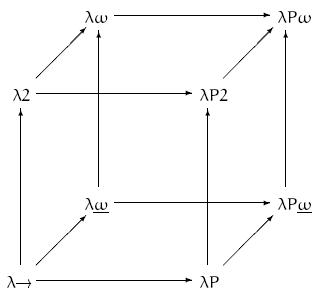Lambda cube

In mathematical logic and type theory, the λ-cube is a framework for exploring the axes of refinement in Coquand's calculus of constructions, starting from the simply typed lambda calculus (written as λ→ in the cube diagram to the right) as the vertex of a cube placed at the origin, and the calculus of constructions (higher-order dependently typed polymorphic lambda calculus; written as λPω in the diagram) as its diametrically opposite vertex. Each axis of the cube represents a new form of abstraction:
- Terms depending on types, or polymorphism. System F, aka second order lambda calculus (written as λ2 in the diagram), is obtained by imposing only this property.
- Types depending on types, or type operators. Simply typed lambda calculus with type operators (λω in the diagram) is obtained by imposing only this property. Combined with System F it yields System Fω (written as λω without the underline in the diagram).
- Types depending on terms, or dependent types. Imposing only this property yields λΠ (written as λP in the diagram), a type system closely related to LF.
All eight calculi include the most basic form of abstraction, terms depending on terms, ordinary functions as in the simply typed lambda calculus. The richest calculus in the cube, with all three abstractions, is the calculus of constructions. All eight calculi are strongly normalizing.
Subtyping however is not represented in the cube, even though systems like , known as higher-order bounded quantification, which combines subtyping and polymorphism are of practical interest, and can be further generalized to bounded type operators. Further extensions to allow the definition of purely functional objects; these systems were generally developed after the lambda cube paper was published.[1]
The idea of the cube is due to the mathematician Henk Barendregt (1991). The framework of pure type systems generalizes the lambda cube in the sense that all corners of the cube, as well as many other systems can be represented as instances of this general framework.[2] This framework predates lambda cube by a couple of years. In his 1991 paper, Barendregt also defines the corners of the cube in this framework.
In his Habilitation à diriger les recherches Lambda-Prolog de A à Z... ou presque , Olivier Ridoux gives a cut-out template of the Lambda cube (p. 70) and also a dual representation of the cube as an octahedron, where the 8 vertices are replaced by faces, as well as a dual representation as a dodecahedron, where the 12 edges are replaced by faces.
See also
- Some of the systems included in the cube were first defined in Automath.
- Homotopy type theory
Notes
References
- Morten Heine Sørensen, Paweł Urzyczyn, Lectures on the Curry-Howard isomorphism, Elsevier, 2006, ISBN 0-444-52077-5, chapter 14, "Pure type systems and the lambda cube"
- H.P. Barendregt, Introduction to generalized type systems, Journal of Functional Programming, 1(2):125-154, April 1991.
- Olivier Ridoux, Lambda-Prolog de A à Z... ou presque, Habilitation à Diriger les Recherches, Université de Rennes 1, 1988 (French) PostScript, PDF, html.
- Pierce, Benjamin (2002). Types and Programming Languages. MIT Press. ISBN 0-262-16209-1.
Further reading
- Simon Peyton Jones and Erik Meijer, 1997. Henk: A Typed Intermediate Language
External links
- Barendregt's Lambda Cube in the context of pure type systems by Roger Bishop Jones